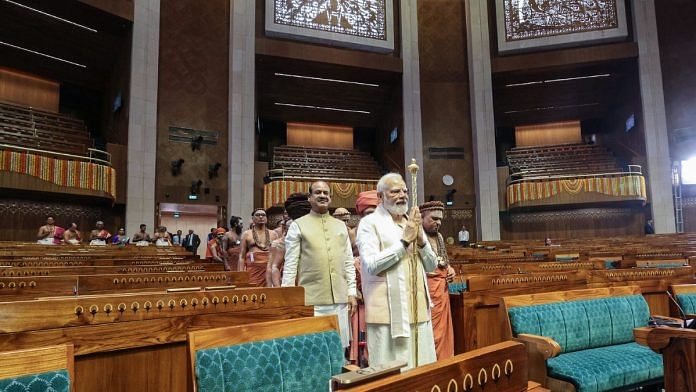The birth of the second republic. That is how a former counsellor to Manmohan Singh described the BJP’s triumph in the general elections of 2014. What he meant was that the liberal State constituted by the anglicised successors to India’s British masters had finally given way to something entirely different. On Sunday, Narendra Modi consecrated the second republic in stone. The triangular odeum he inaugurated is more than the new home of India’s Parliament. It is a monument to what the prime minister and his worshippers reverently call “New India”.
For more than six decades, Indian democracy’s most mundane and consequential deliberations unfolded within the annular walls of the discarded Parliament House designed by Herbert Baker. At Independence, India’s founding personalities hallowed the place by convening under its majestically domed central hall, where Jawaharlal Nehru, at the stroke of the midnight hour on 15 August 1947, proclaimed the birth of modern India.
The new Parliament, opened on the 140th birth anniversary of Vinayak Damodar Savarkar, the father of Hindu supremacism, trumpets a nativist break from that past. The colonial affiliation of the old Parliament House had actually had a democratising effect: no faction could be proprietorial about it, and all Indians could lay claim to it. Generations of Indian citizens regarded it not as a structure grafted on the subcontinental soil but as an edifice excavated from the Indian earth.
Also read:
Modi revived a dead idea
The idea of a new building predates Modi, of course. It was first floated by Manohar Joshi, who, as speaker of the Lok Sabha in 2002, convinced himself that the building in which he worked was cursed. A string of his seniormost colleagues had perished in quick succession. His predecessor was killed in a freak helicopter crash months before Parliament convened that monsoon. The vice-president of India died when Parliament was in session.
Joshi summoned Ashwinie Kumar Bansal, a lawyer and a specialist in vastu, to survey Parliament House and recommend alterations. Bansal, overwhelmed by the “negative vibrations and energy” he detected in the building, urged the speaker to vacate it post-haste. Bansal’s report, commissioned and reviewed in all seriousness, was never acted upon. In 2004, Joshi lost his own seat. The NDA government, citing wear and tear and health and safety concerns, considered refurbishing the building or relocating Parliament. The idea died a natural death—until Modi resuscitated it.
Legislators will now be housed in a building that is the product of a monocratic project to memorialise Modi for the ages. The first republic’s founders were dedicated to building institutions. The second republic’s custodians are devoted to entrenching a cult of personality. Constitutional propriety was stamped on, official hierarchy upended, and the head of the State cast aside—all to make way for the most sectarian leader in India’s republican history to pitch the building as his material bequest to the country.
Also read:
Entrenching a cult of personality
The atmosphere of the proceedings on Sunday granted a glimpse of the second republic in maturity. A large chunk of the opposition was absent. The deputy chief minister of Delhi was in jail. The pre-eminent leader of the Congress Party had recently been disqualified from membership of Parliament. The president of India, sitting a five-minute drive away, was not even extended the courtesy of a perfunctory invitation. Those who did attend—the men and women sent to make laws for India—howled Modi, Modi, with the self-abasing sycophancy of Serb nationalists shrieking Slobo, Slobo.
This squalid spectacle was preceded by religious theatre—prayers, prostrations, ash-smeared sadhus in a place where they did not belong—and ornamented with a ceremonial mace intended to burnish the event with historical pedigree. The golden staff, called Sengol, was repeatedly exalted by the BJP in the days leading up to the opening as an indigenous symbol of transfer of power.
But who was transferring power to whom?
The British ceded control to Indians 75 years ago and left. Since then, movement of power has been determined by the ballot. Modi was taking part in an elaborate mimicry of India’s freedom at midnight. But because his side had played no constructive role in that achievement—because the heroes on his side had in fact submitted cravenly to the colonial system, despised Mohandas Gandhi, and moonlighted as allies of Muhammad Ali Jinnah—the reproduction was bereft of substance and reeked of deceit.
Reprising old rituals and receiving a sceptre from priests will not loft Modi into Nehru’s league. Nehru and his comrades prised power from the clenched fists of the most powerful empire in history. Modi pantomimed before an audience of abject yes-men. It was a fulsome display of the sham that is New India.
Kapil Komireddi is the author of ‘Malevolent Republic: A Short History of the New India’, which will be published in a revised and updated edition next month. Follow him on Telegram and Twitter. The views expressed above are personal.
(Edited by Zoya Bhatti)



